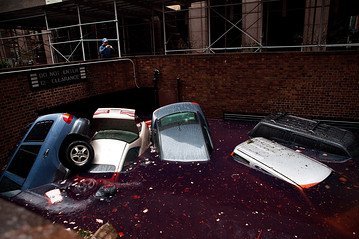After a Hurricane, Where Do All the Flooded Cars Go?

"Good thing he moved it," his wife, Robin, said by phone.
Many thousands along the eastern seaboard weren't as lucky. The giant hurricane is taking a heavy toll on cars and trucks throughout the region—either swamping them in floodwaters or inflicting damage through fallen branches or downed trees.
No estimates are available on the number of vehicles that might be damaged but media reports are showing plenty of submerged and wrecked cars from Cape May, N.J., to lower Manhattan to Long Island, N.Y.
Hurricanes typically bring a boomlet in auto sales to regions that are affected, said Pete DeLongchamps, vice president for manufacturer relations at Group 1 Automotive Inc., a large dealership chain that owns four stores on Long Island and six in New Jersey, including three near the hard-hit resort of Atlantic City.
"We usually see it over about the next 60 days," he said by phone from the company's headquarters in Houston. "People need to get to work, so they go out pretty quickly to get a new car."
Years ago, the industry had a rule of thumb about cars caught in floods—if the water rose to the level of the ashtray, the car was totaled, unfixable. But these days it doesn't always take waist-deep water to turn cars into junk—mainly because today's vehicles are jammed with sensitive electronics that are expensive to replace.
Even if they are repaired, owners of waterlogged vehicles may be forced to scrap them. Vehicle damage reports like CarFax are widely available on the Internet and make it easy to spot cars that have been suffered heavy flood damage, said Ricky Beggs, vice president and managing editor of Black Book, a guide to the wholesale market for used car dealers.
The damage to cars from floods can be extensive depending on the water level, length of time in the water and type of water including contaminants, consumer advocates say. More than 600,000 vehicles had some level of water damage after Hurricane Katrina struck the Gulf region in 2005. Many of those vehicles were resold, sometime to unsuspecting customers in far away states who weren't aware of the damage.
Due to the wide swath of the storm damage up and down the East Coast, "the impact could be bigger than Katrina," Mr. Beggs said. There is a strong possibility that newer models will need to be replaced because the Northeast has a higher concentration of leased vehicles which are only a few years old, he said. That could boost both the new and used car markets, according to Mr. Beggs.
Sandy has posed danger for auto dealers as well as owners. Dealerships tend to be located on high ground, away from flood zones, but their inventories of cars can be exposed to downed power lines, or wind or hail damage. Even if cars suffer minor damage, they sometimes can no longer be sold as new, lowering their value to dealers.
From its Houston headquarters, Group 1 prepares for the hurricane season every summer. Company executives began holding conference calls last week with store managers in Sandy's path, said Brooks O'Hara, vice president of human resources. The managers were advised to make sure their underground gasoline tanks were filled, in case the storm slowed fuel deliveries. Any vehicles in for repairs were to be fixed and returned to owners, leaving room in dealership garages for as many new cars as they could jam in, he said.
"We learned a lot from Katrina and we go through this all the time, being down in the Gulf," Mr. O'Hara said.
Related News


